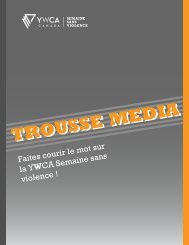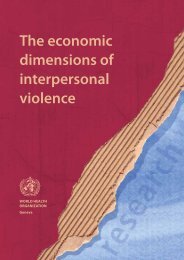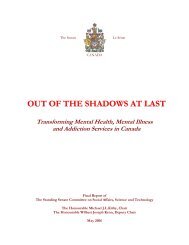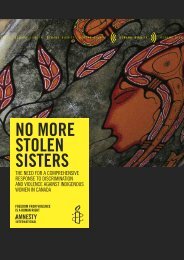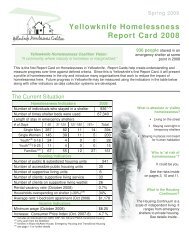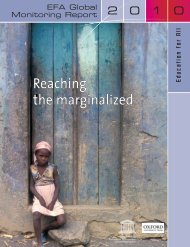Gender Report Card on the International Criminal ... - YWCA Canada
Gender Report Card on the International Criminal ... - YWCA Canada
Gender Report Card on the International Criminal ... - YWCA Canada
Create successful ePaper yourself
Turn your PDF publications into a flip-book with our unique Google optimized e-Paper software.
Structures & Instituti<strong>on</strong>al Development Structures<br />
ICC Staff<br />
Recruitment of ICC Staff 19 men women<br />
Overall staff 20<br />
(698 including professi<strong>on</strong>al and general posts, and elected officials excluding judges) 54% 46%<br />
Overall professi<strong>on</strong>al posts 21 (357 including elected officials, excluding judges) 52% 48%<br />
Judiciary Judges 22 42% 58%<br />
Overall professi<strong>on</strong>al posts 23 (excluding judges) 39% 61%<br />
OTP overall professi<strong>on</strong>al posts 24 54% 46%<br />
Registry overall professi<strong>on</strong>al posts 25 52% 48%<br />
12<br />
19 Figures as of 31 July 2011. Informati<strong>on</strong> provided by <strong>the</strong> Human Resources Secti<strong>on</strong> of <strong>the</strong> ICC.<br />
20 These figures relate to posts which are occupied as of 31 July 2011. The overall number of staff positi<strong>on</strong>s occupied increased<br />
by <strong>on</strong>e individual compared with 2010. The percentage of female and male professi<strong>on</strong>als has slightly changed from 2010 when<br />
<strong>the</strong>re were 53% men and 47% female employees at <strong>the</strong> Court. Figures from <strong>the</strong> ICC as of 31 March 2011 for existing positi<strong>on</strong>s<br />
indicate <strong>the</strong>re were 702 established filled posts, 193 posts approved as general temporary assistants (GTA), 86 interns, seven<br />
visiting professi<strong>on</strong>als, 49 c<strong>on</strong>sultants and 23 elected officials including <strong>the</strong> Judges, <strong>the</strong> Prosecutor, <strong>the</strong> Deputy Prosecutor, <strong>the</strong><br />
Registrar and Deputy Registrar. Please note that <strong>the</strong> last two positi<strong>on</strong>s are not elected by States Parties. (See <strong>the</strong> <str<strong>on</strong>g>Report</str<strong>on</strong>g> of <strong>the</strong><br />
Committee <strong>on</strong> Budget and Finance <strong>on</strong> <strong>the</strong> work of its sixteenth sessi<strong>on</strong>, ICC-ASP/10/5, 17 June 2011, p 35). In total, 761 established<br />
posts were approved by <strong>the</strong> ASP in <strong>the</strong> 2011 budget.<br />
21 This year, <strong>the</strong> total number of occupied professi<strong>on</strong>al posts, including elected officials but excluding judges, is 357 or 51% of <strong>the</strong><br />
overall staff. Last year, professi<strong>on</strong>al posts were 51.5% of <strong>the</strong> total. After two years during which half of <strong>the</strong> professi<strong>on</strong>al posts at<br />
<strong>the</strong> Court were occupied by women, this year female professi<strong>on</strong>als are 48% of <strong>the</strong> total.<br />
22 There are currently 19 judges <strong>on</strong> <strong>the</strong> bench of <strong>the</strong> ICC of which 11 (58%) are women and eight (42%) are men. For <strong>the</strong> third year<br />
in a row, women are <strong>the</strong> majority <strong>on</strong> <strong>the</strong> bench. Article 36 of <strong>the</strong> Rome Statute outlines <strong>the</strong> bench of <strong>the</strong> ICC as being comprised<br />
of 18 judges. Judge René Blattmann (Bolivia), whose term ended in March 2009, remains <strong>on</strong> Trial Chamber I until it renders its<br />
decisi<strong>on</strong> in <strong>the</strong> Lubanga case. The electi<strong>on</strong> of new judges, to replace <strong>the</strong> six judges whose terms are finishing in March 2012,<br />
will be held during <strong>the</strong> tenth sessi<strong>on</strong> of <strong>the</strong> Assembly of States Parties from 12 to 21 December 2011 in New York. Of <strong>the</strong> judges<br />
whose terms will come to completi<strong>on</strong> in 2012, three are women (Judge Diarra – Mali, Judge Odio Benito – Costa Rica, and Judge<br />
Steiner – Brazil). The nominati<strong>on</strong> period for <strong>the</strong> electi<strong>on</strong> of judges was open between 13 June and 16 September 2011. Of <strong>the</strong> 19<br />
judicial nominees, <strong>on</strong>ly two are women of whom <strong>on</strong>e is from <strong>the</strong> Group of Latin America and <strong>the</strong> Caribbean regi<strong>on</strong> (Olga Venecia<br />
Guerrera Carbuccia – Dominican Republic) and <strong>on</strong>e from <strong>the</strong> Asia regi<strong>on</strong> (Miriam Defensor-Santiago – <strong>the</strong> Philippines).<br />
23 These figures represent <strong>the</strong> actual posts filled in <strong>the</strong> Judiciary. Women c<strong>on</strong>stitute 61% of <strong>the</strong> total professi<strong>on</strong>al staff in <strong>the</strong><br />
Judiciary. Female professi<strong>on</strong>als have been <strong>the</strong> majority in <strong>the</strong> Judiciary since 2007 predominantly in <strong>the</strong> mid and lower level posts<br />
with women comprising <strong>the</strong> majority at <strong>the</strong> P3 level (12 women, nine men). At <strong>the</strong> more senior levels, male professi<strong>on</strong>als slightly<br />
exceed women in <strong>the</strong> P4 posts (two men and <strong>on</strong>e woman), while <strong>the</strong> three P5 posts are occupied by two males (Senior Legal<br />
Adviser, based in The Hague; Chef de Cabinet, based in The Hague,) both from <strong>the</strong> WEOG regi<strong>on</strong> and <strong>on</strong>e woman (Head of <strong>the</strong><br />
New York Liais<strong>on</strong> Office, based in New York) from <strong>the</strong> Africa regi<strong>on</strong>. Until 2011, <strong>the</strong> Judiciary had reported <strong>on</strong> <strong>the</strong> appointments<br />
for three P5 established positi<strong>on</strong>s. This year, <strong>the</strong>y reported <strong>on</strong>ly <strong>on</strong> two P5 posts and described <strong>the</strong> Chef de Cabinet positi<strong>on</strong> as<br />
vacant and filled <strong>on</strong> a GTA c<strong>on</strong>tract.<br />
24 This year, <strong>the</strong>re is a 3% decrease in <strong>the</strong> overall number of women appointed to professi<strong>on</strong>al posts in <strong>the</strong> OTP. This decrease<br />
has been predominantly at <strong>the</strong> P3 level. The female/male differential remains high in all senior positi<strong>on</strong>s with both D1 posts<br />
occupied by men, almost three times <strong>the</strong> number of male appointees at <strong>the</strong> P5 level (three women and eight men) and 24%<br />
more males than females appointed at <strong>the</strong> P4 level (10 women and 16 men). These figures are <strong>the</strong> same as in 2010. At <strong>the</strong> P3<br />
level, <strong>the</strong>re are 15 (36.5%) female appointees and 26 (63.5%) male appointees. Female professi<strong>on</strong>als are <strong>the</strong> majority at <strong>the</strong> P1<br />
and P2 levels, comprising respectively 69% and 58% of those appointed to <strong>the</strong>se posts.<br />
25 For <strong>the</strong> past five years, <strong>the</strong> overall recruitment statistics for professi<strong>on</strong>al appointments within <strong>the</strong> Registry has remained within<br />
<strong>the</strong> 52% – 48% range. This year <strong>the</strong>re are 52% male and 48% female appointees, in 2010 <strong>the</strong> figures were 51% and 49% and<br />
in 2009 <strong>the</strong> figures were 48% and 52%. There are still three times more men than women appointed at <strong>the</strong> D1 level, and 26%<br />
more men than women appointed at <strong>the</strong> P3 level. In 2011, <strong>the</strong>re are eight men and seven women appointed at <strong>the</strong> P5 level, and<br />
women are <strong>the</strong> majority at <strong>the</strong> P4 (56%), P2 (53%) and P1 (62%) levels.








